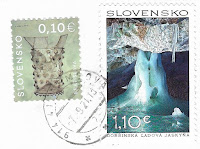I read a few years ago the book For Whom the Bell Tolls by Ernest Hemingway, a great novel about the Spanish Civil War, where the Escurial is several times mentioned.
 |
| Monastery of San Lorenzo de El Escurial |
This postcard was sent by Edit
Built at the end of the 16th century, the Escurial Monastery stands in an exceptionally beautiful site at the foothills of the Sierra de Guadarrama, north of Madrid. It was the retreat of a mystic king, Philip II, and became in the last years of 'his reign the centre of the greatest political power of the time.
Philip II founded the monastery in 1563 as a votive monument and pantheon to the Spanish monarchs from the Holy Roman Emperor Charles V onwards. Its design, which is complex yet also simple, was created by Juan Bautista de Toledo, Spanish pupil of Michelangelo during the works of the Vatican Basilica, and completed by Juan de Herrera after Toledo’s death.
 |
| Monastery of San Lorenzo de El Escurial |
This postcard was sent by Marco
The royal site includes the monastery, a stone complex of extraordinary dimensions surrounded by formal gardens and the monks’ gardens, the House of Trades, and the Company Quarters where the palace and monastery services were accommodated. In the 18th century, the new Houses of Trades were built, completing the Lonja (the stone esplanade), and, consequently, a small town arose around the monastery, becoming a model of the Enlightenment, accommodating the court as well as the two country villas for Charles III’s sons.
Within the monastery’s massive volume, there is an ensemble of different buildings: the monastery, the church, the royal palace, the school, the seminary, and the royal library, brilliantly organised around eleven main courtyards and three service courtyards. Some say, the design is similar to that of the grill, the instrument used for St Lawrence’s martyrdom. Its austere architecture, a sparsely ornate style, known as “herreriano”, was a break with previous styles, and had a deep influence on Spanish architecture for more than half a century. Notwithstanding, several rooms do have a very rich and sublime decoration. Contemporary writers praised it as one of greatest paradigms of the arts: the “Eighth Wonder”.
The Royal Monastery and Site of St Lawrence of the Escurial is the monument that symbolises the ideological and artistic expression that inspired and represented the Spanish Catholic Monarchy during the Golden Age, between the 16th and 17th centuries, as well as its permanence until the end of the Ancien Régime. - in: http://whc.unesco.org/en/list/318










































